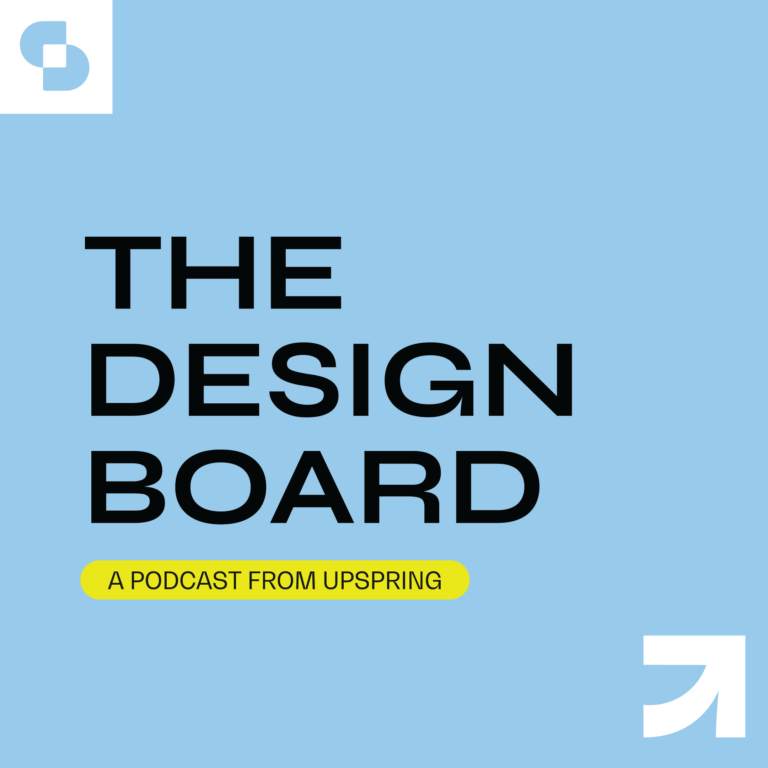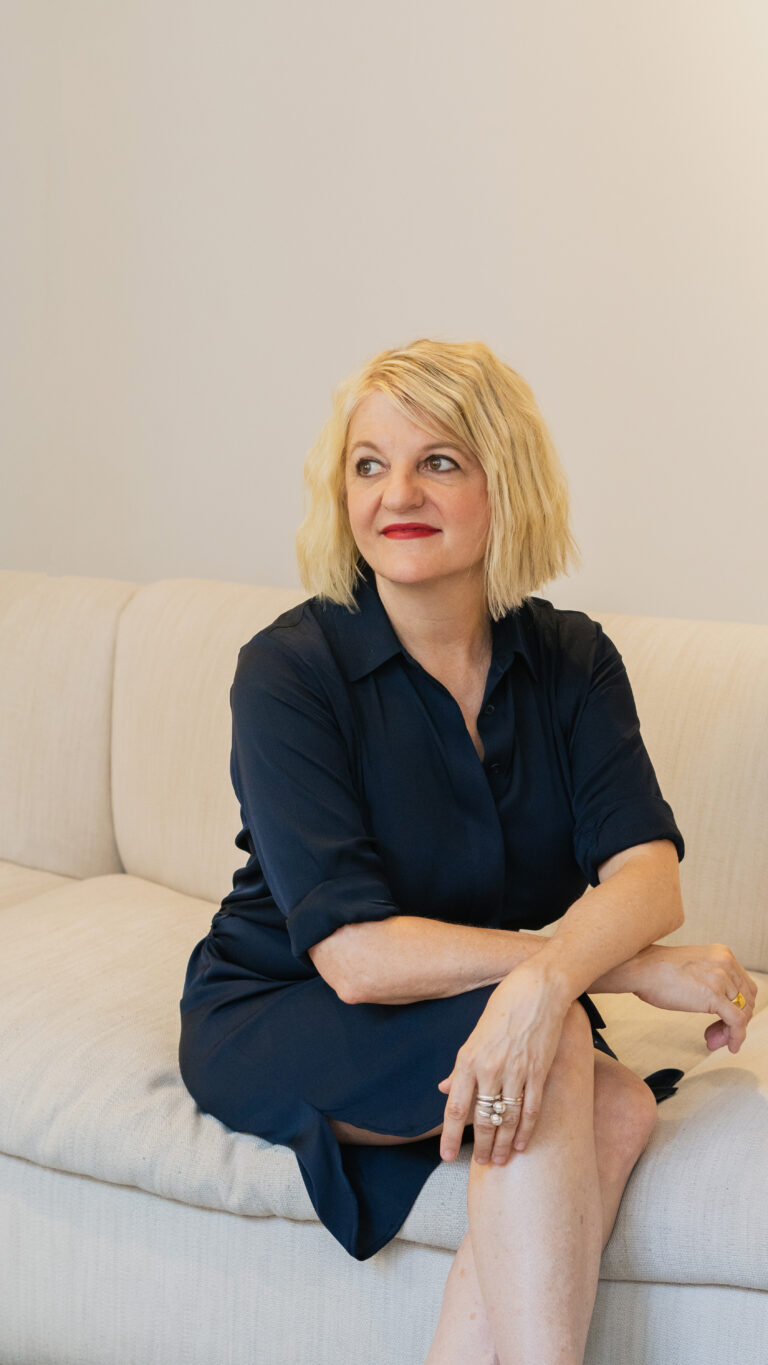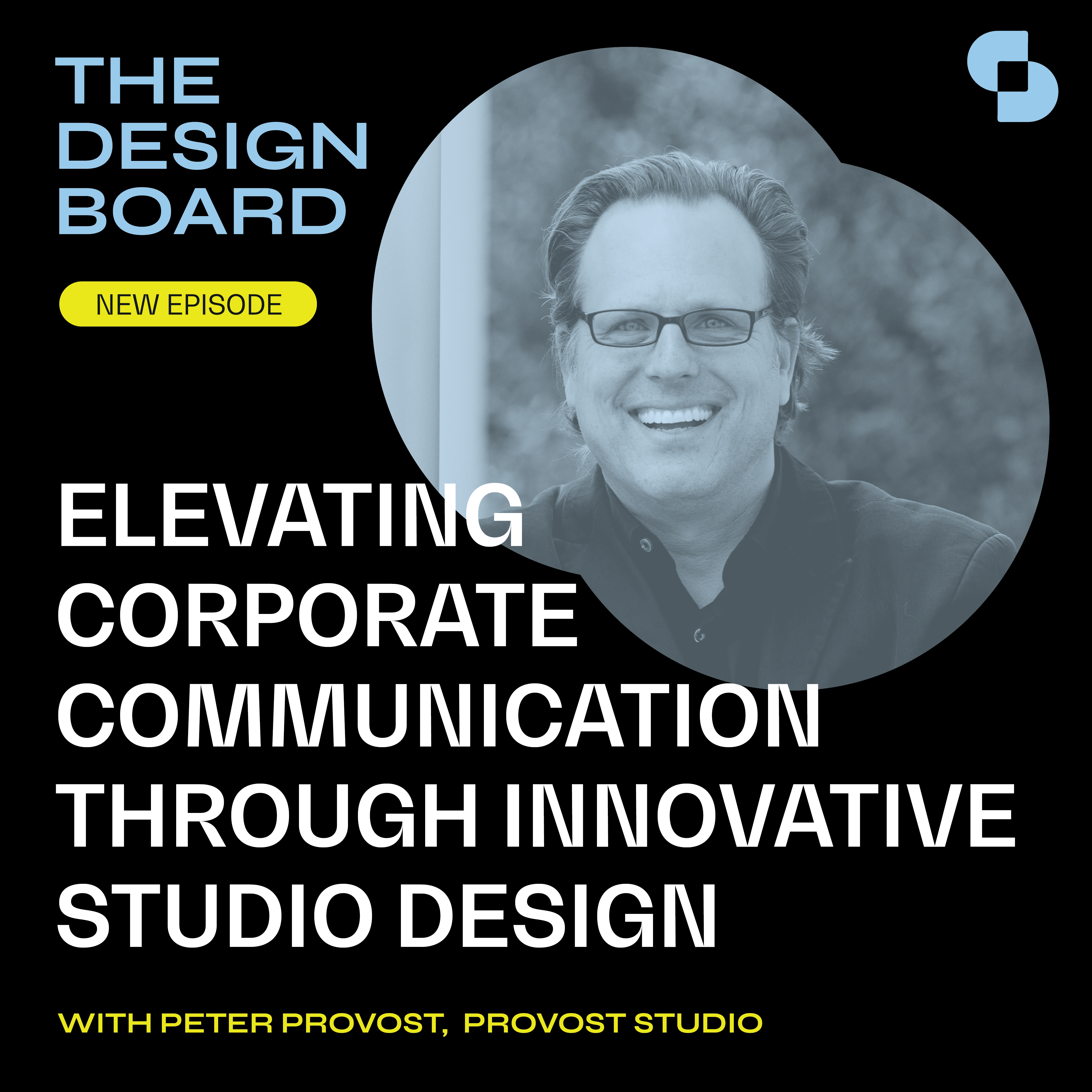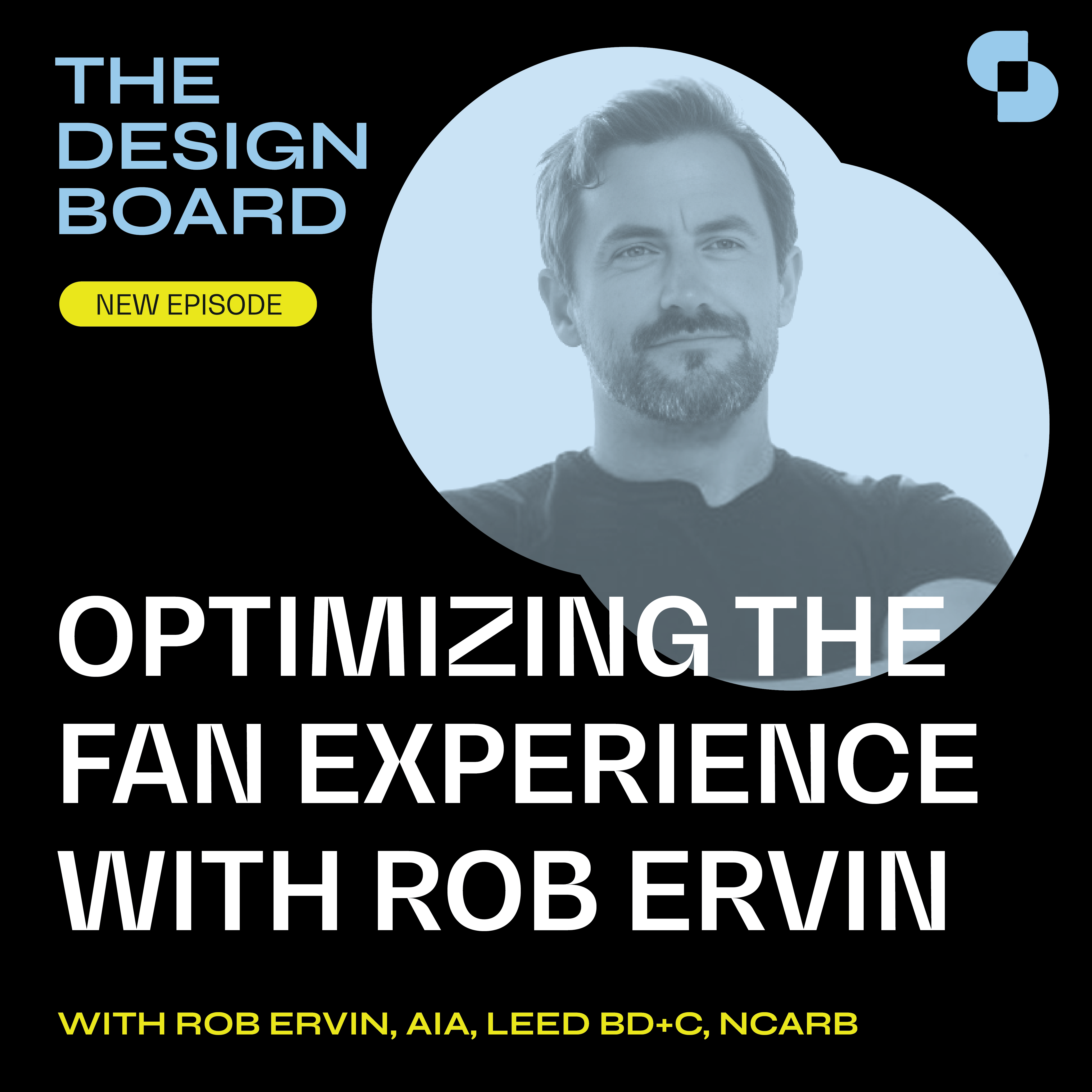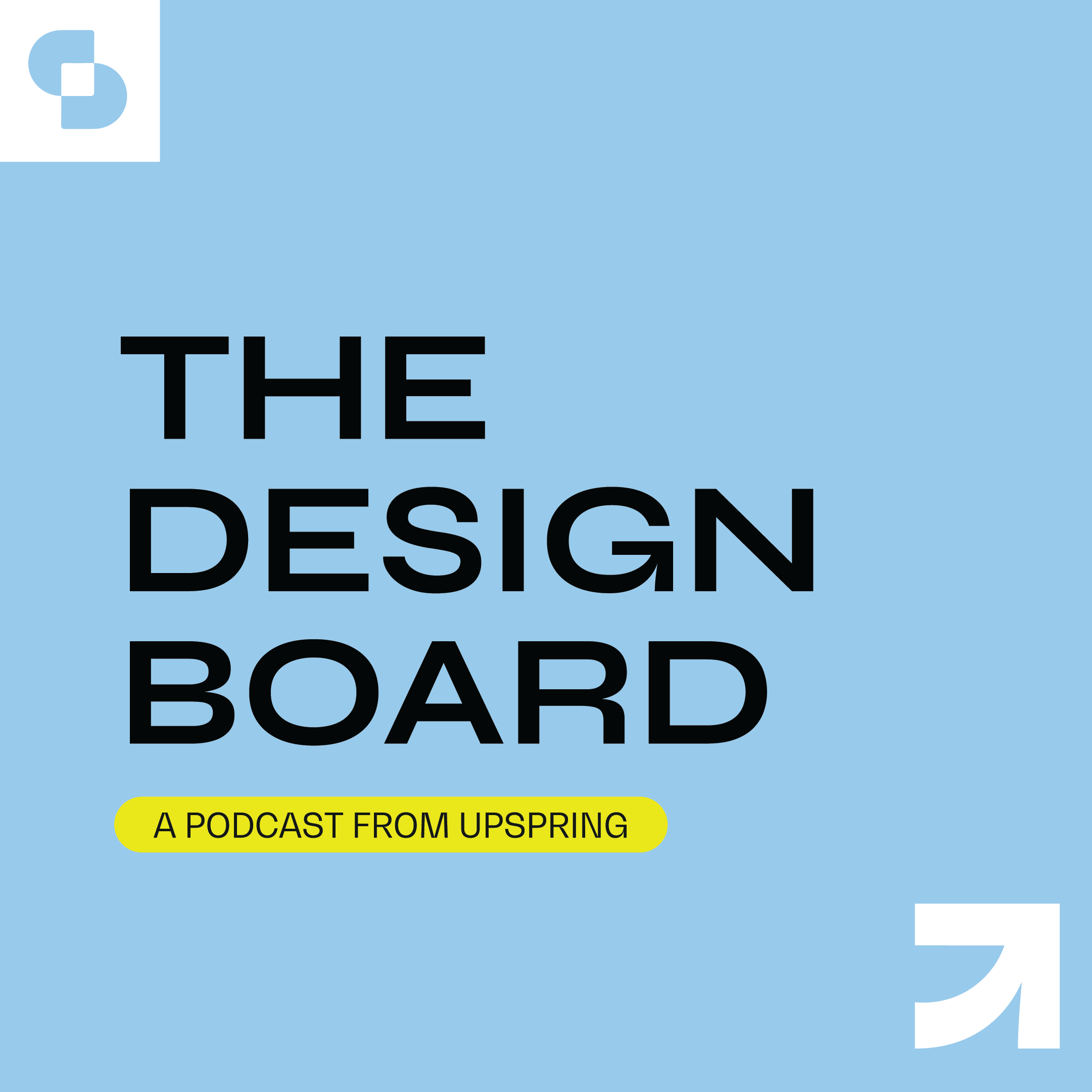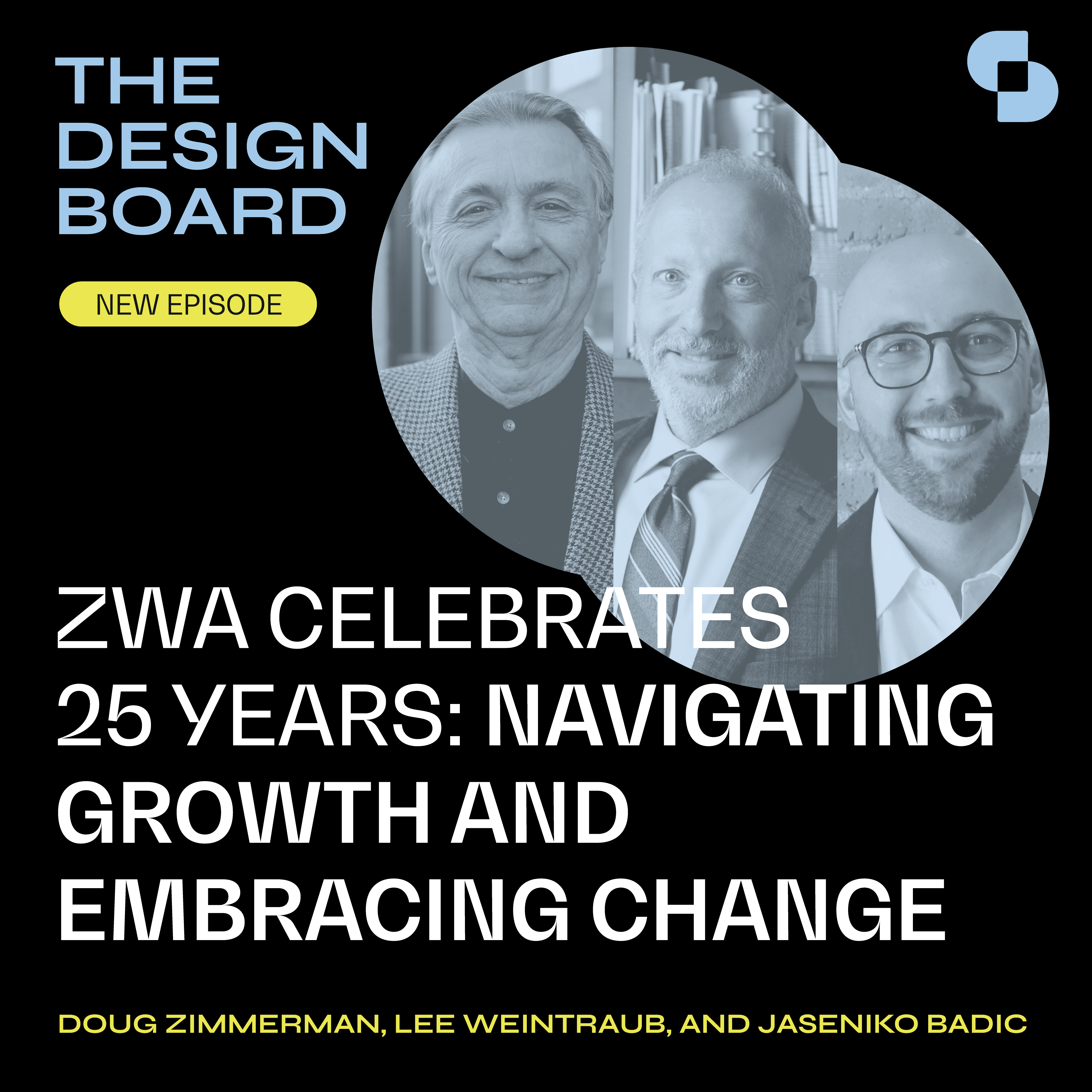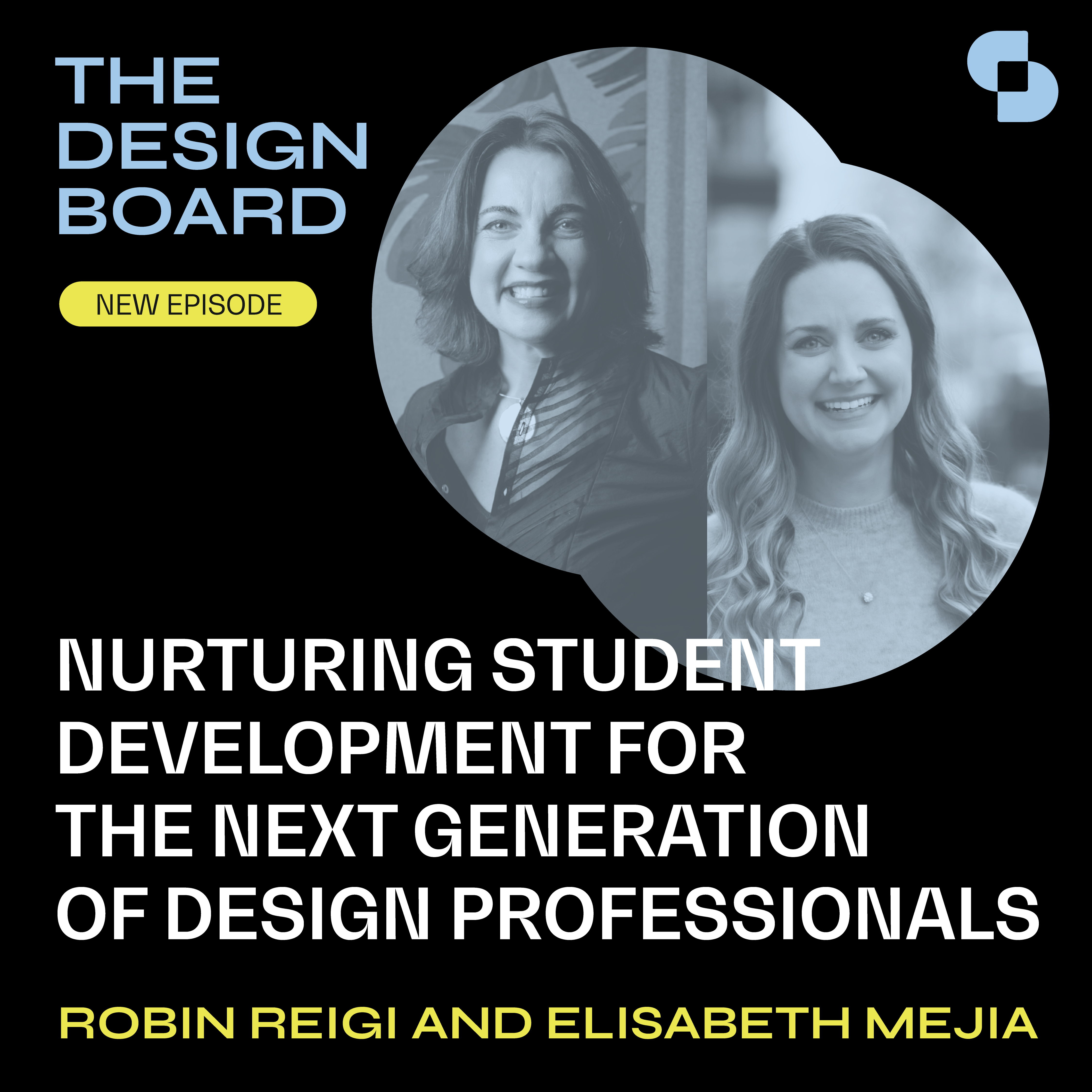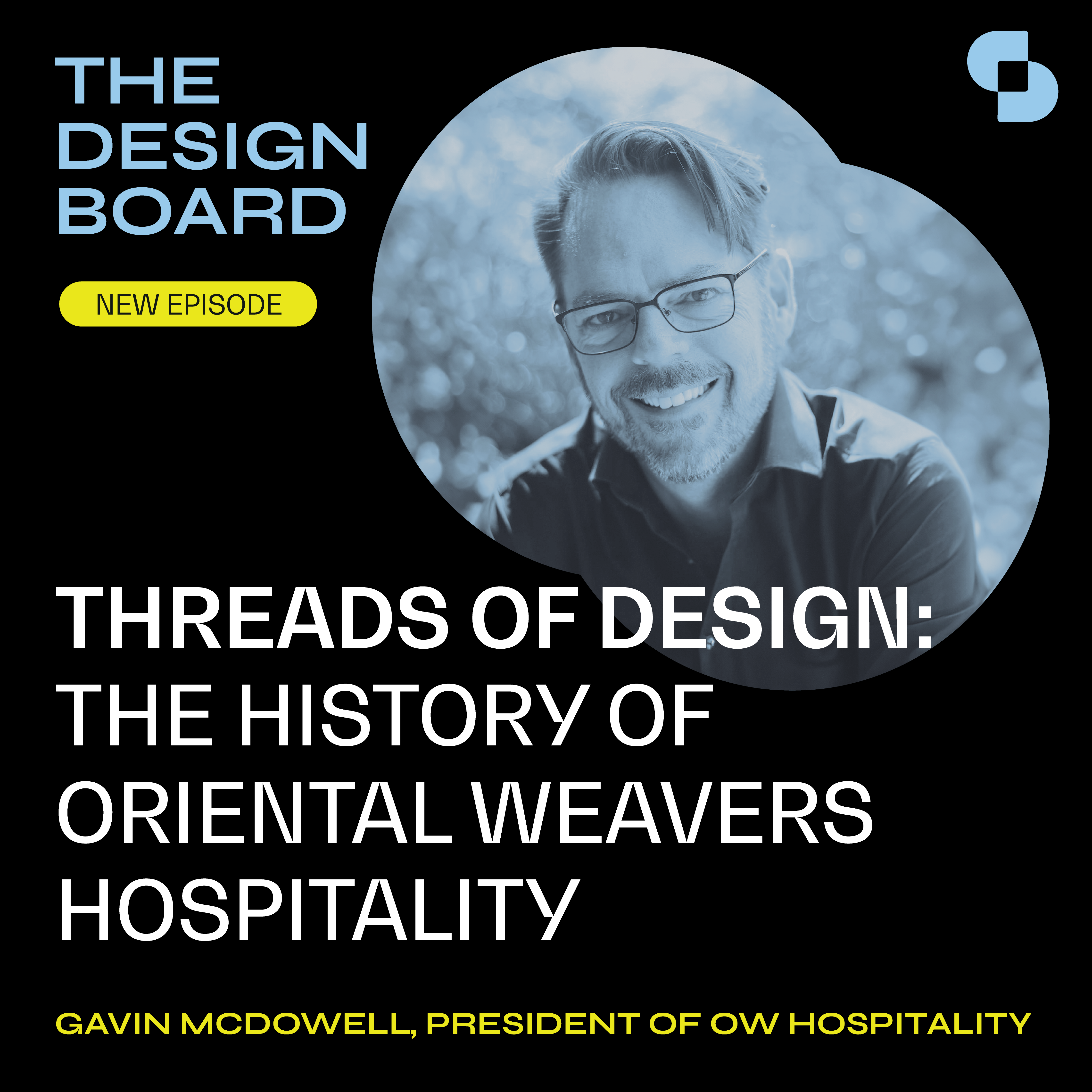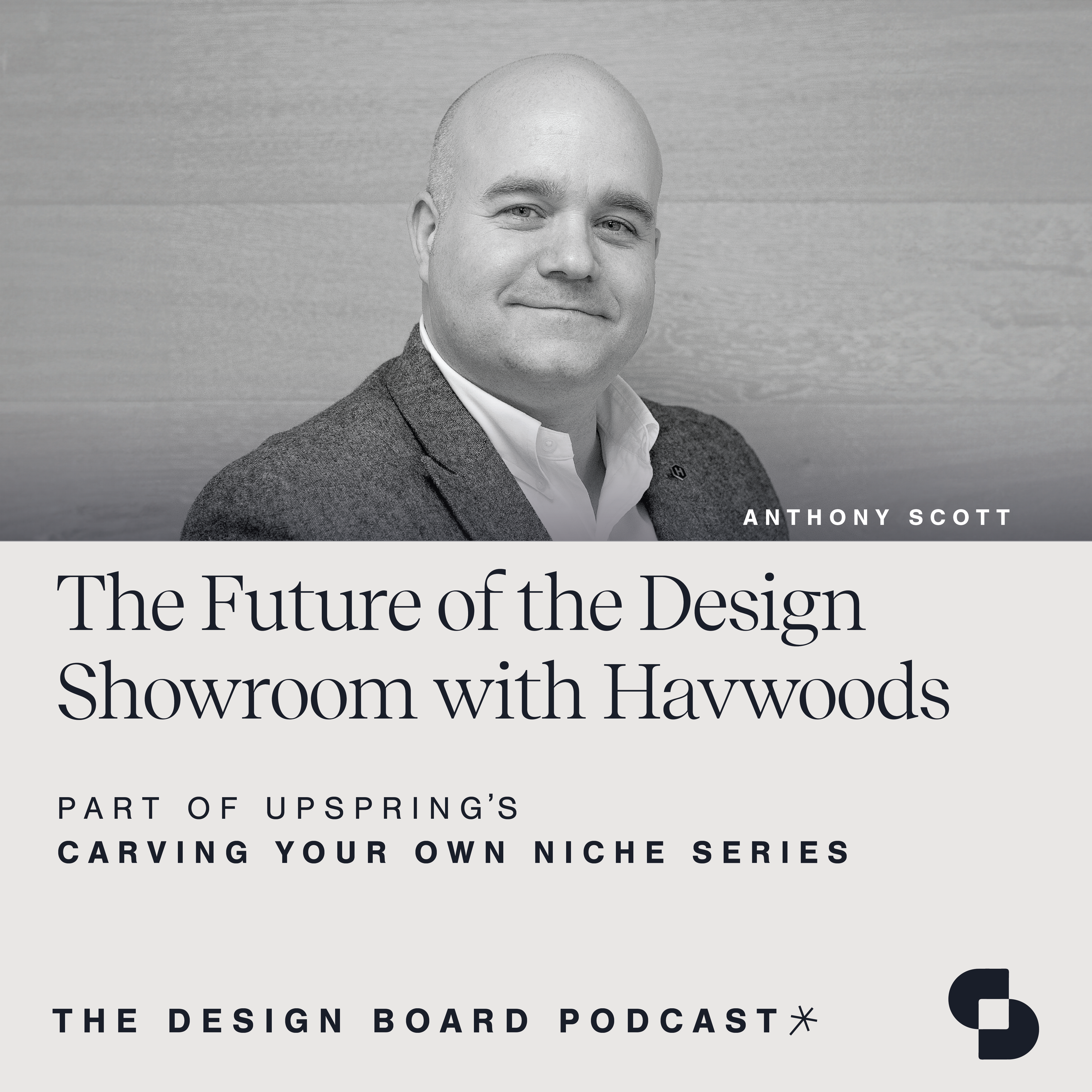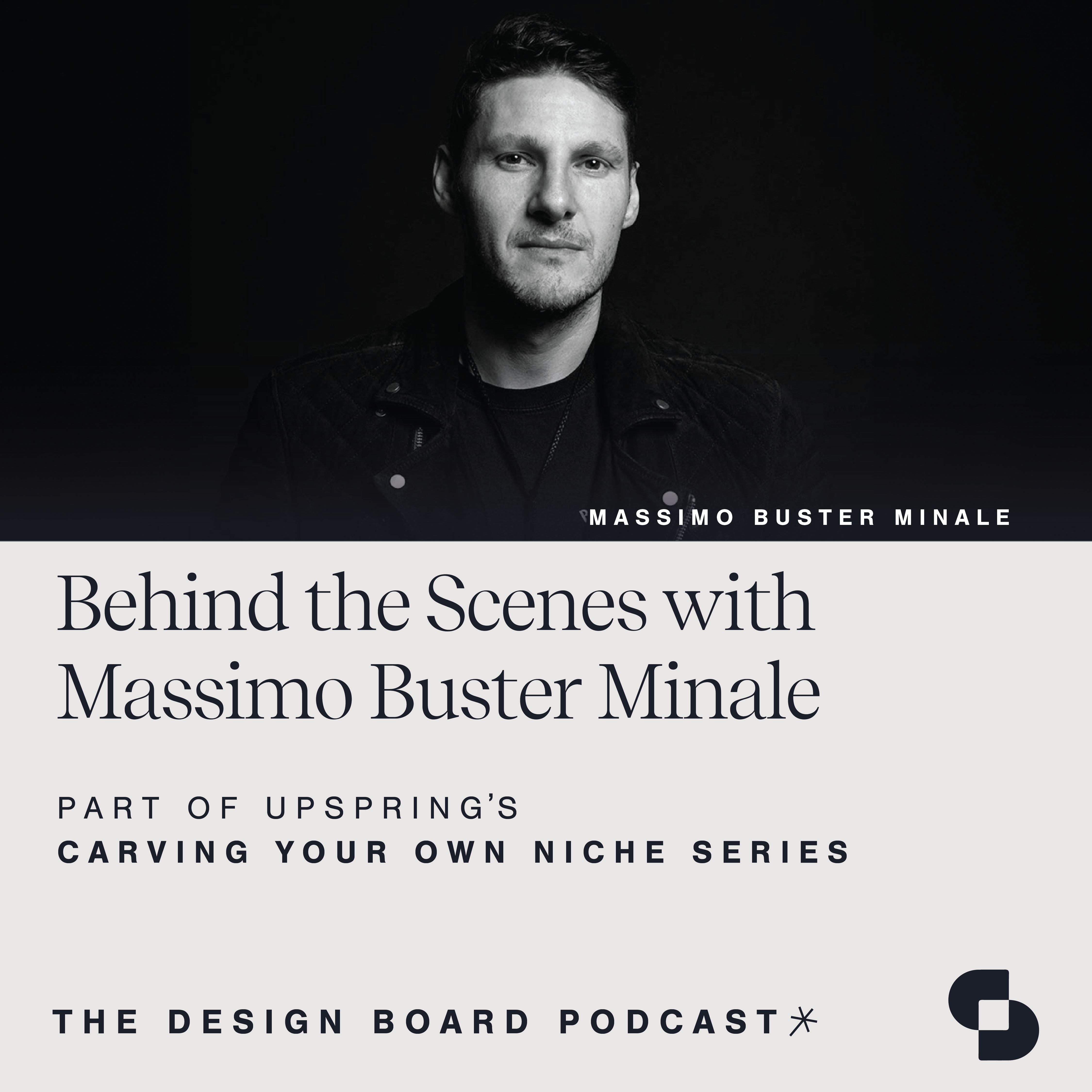In this episode, host Susan Fernandez sits down with Melissa Muszynski, the founder and creative director of MBM Design. From early childhood experiences of rearranging her mother’s kitchen to founding her own thriving interior design business, Melissa’s journey is inspiring. This episode explores how Melissa turned her lifelong passion for transforming spaces into a successful career. She shares her experiences, challenges, and triumphs, from tackling complex projects and remaining resilient and adaptable in the pursuit of excellence.
The Design Board, by UpSpring, is a proud member of SANDOW Design Group’s SURROUND Podcast Network, home to the architecture and design industry’s premier shows.
Speaker 1:
Welcome to The Design Board, a podcast created by the team at UpSpring that focuses on design, development and everything in-between. We invite innovators in our industry and explore topics that support your growth in every way. The Design Board is a proud member of SURROUND, a podcast network from SANDOW Design Group, featuring the architecture and design industry’s premier shows. Check it out at surroundpodcast.com.
Susan Fernandez:
Welcome everyone to The Design Board, a podcast by UpSpring, that focuses on design, development and everything in-between. We host innovators in our industry and explore topics that support your growth in every way. I’m your host, Susan Fernandez, and today I’m joined by Melissa Muszynski, founder and Creative Director of MBM Design. While Melissa has been designing spaces for friends and family since she was seven years old, she initially chose a career in public relations. When a freak accident resulted in a traumatic brain injury in the form of a concussion, Melissa used her recovery time to reflect on her professional choices. Having to stay in rest mode while her brain was healing reignited her belief that a well-designed interior could in fact promote a healthy state of mind.
Melissa is the founder and Creative Director of MBM Design. She offers full-service residential and commercial interior design and strategic project management services to her clients. She has the expertise to take on projects of all sizes and complexities, ranging from single-family homes to multi-storey residences and offices. This discussion will focus on her life-changing decision to embrace her inner design guru and switch careers. Melissa, welcome to the show.
Melissa Muszynski:
Thank you for having me. I appreciate it.
Susan Fernandez:
Oh my gosh, I’m so excited for this conversation. I am absolutely inspired by your story and I know that our listeners will be as well. So let’s start at the beginning. I feel like for all of us, if we’re lucky enough, we have a friend or family member who is a semi-pro interior designer. That person who just seems to intuitively know how to make a space work, they always give us great advice and they see something we miss. So I believe that’s where you started. So can you tell us about the first time you felt called to design?
Melissa Muszynski:
Sure. So I am an only child, and when I was growing up, my parents worked full-time, both demanding jobs, and a lot of the times I was by myself. They were rushing to get dinner done, doing the laundry, and I just found a creative outlet to routinely redesign my room and to redesign our house that we lived in. And it absolutely drove my parents nuts because they would come home after working all day and the table and the chairs would be somewhere else. I would have my mom’s antique scarves, heirloom scarves on the floor as a new leopard walkway. And it just was a great opportunity for me to be able to search for what my creative side would be. I think children should be bored sometimes, right? And be able to come up with ways to keep them busy. And I think through that, creativity is formed. So starting at the age of seven is when I could remember when I started redesigning my parents’ house.
Susan Fernandez:
Well, at age seven, you had what we call proof of concept, right? From idea to installation, and yet you chose a different career. So how did you choose PR above design?
Melissa Muszynski:
So I went to school for communications, and I decided to go that route after doing an internship at our state capital. I was inspired by what happens at the Connecticut State legislature. I was intrigued by how politicians work with lobbyists to create legislation and decided to go into communications to try and shape people’s stories. So from a very young age, I always enjoyed talking with people, talking with strangers, hearing their story and trying to shape what their next chapter was, which led me into working with state politicians. I did that for many years and worked for state agencies and enjoyed it very much.
Probably back about five years ago, five or six years ago, I launched a very large press event for a transportation project our state undertook and was just about near completion. And I remember talking to my boss and I said to him, “This project is amazing. It’s almost completed. We put three press conferences on at once. This is great. What’s next?” And he had said to me, “What are you talking about? This is a legacy project. This is a project that happens only 20 years. So this high that you’re feeling right now, you’re not going to feel it again for 20 years.” And I, “20 years? I have to wait for something good like this to happen again? This was crazy.”
So it started really getting me thinking about how I can be more creative every day and not wait for these legacy projects. So that happened probably in 2018, and then if you’d like, I can talk about what happened in 2019 that really opened up my eyes literally into making a career change.
Susan Fernandez:
Absolutely. So just one comment on what you’ve said. The diplomacy you learned through PR, I know has served you in design. I think so many people think about the end result, but really getting that client vision, which we’ll talk a little bit about later. My favorite part of life and all the people that I am most attracted to, and I think it just reflects who we are as human beings, is when someone uses a life-changing event to become a new, a better version of themselves. So you were talking about what happened to you in 2019. Can you walk us through that? What happened and how did it spark this transformation?
Melissa Muszynski:
Sure. So March of 2019, I was with my husband and two kids, and we of course were at Home Depot, and I was checking off the list of everything we had to do this weekend that most of us do. And I was putting all of the bags in the trunk and the kids obviously were talking loud, I couldn’t hear. My husband had hit the button to close the trunk, but didn’t turn around and see that I was still in the trunk. So slowly the trunk and I collided, my head and the trunk collided, and I fell to the ground and the trunk bracket that closes, that locks into the car hit the left side of my brain, which affected everything on your right side.
So long story short, I was home for all of 2019 and I couldn’t drive for three months. I couldn’t write a check, I couldn’t read long. My brain was just so shooken up by this impact on the trunk that I literally was homebound, couldn’t go anywhere, couldn’t go outside. The light was too bright, the noise was too much. So I really just rested and laid down for a few months and it was the hardest time in my life because for someone like me, I’m always on the go. I love talking to people, and by only being able to talk to someone literally a minute on the phone and you’re feeling this pressure in your head is really debilitating and it’s really depressing.
So I was home for that entire year and during that summer, as I was laying down a lot, I would look at the environment around me and I would look at the artwork on the walls. I would touch the blanket and the pillow that was on the couch and looking at items that I had purchased, collectibles, artwork. That was a moment for me when I looked around and I said, “I never was able to appreciate everything that I had in this home.” Until you hit rock bottom and you have to look at it and you have to look at your home environment and say, “I need you to help me recover. I need to be able to look at these pieces because I can’t go anywhere, and the only way I can get comfort and joy is in my home.”
And for so many of us, and I get it, right? I see this every day, is we use our home as a stopping ground. We put our purse down, we sit at the table and we eat dinner, we put our dishes in the sink, and we’re just utilizing this space, but we’re not embracing and we’re not appreciating this space. So I had said to my husband in the late fall of 2019, I said, “I’m telling you right now, if I can make a full recovery, I am not going back to corporate America and I’m going to do something that I truly love where I can bring joy and peace and beauty back into more homes, not just mine.” And he had said, “Okay, let’s just keep doing, keep seeing your neurologist and let’s see where this goes.”
Winter 2019, I had said, “I’m feeling a lot better and I can go back to work, but I really don’t want to. What can I do?” And he had said, “You got to look inside and figure this out.” So I said, “Ah, okay. I know what I’m going to do. Whenever I’m unsure and I need some guidance, one, yes, I’m going to try and meditate on it and visualize what this looks like, but for a quick answer, I’m going to call my medium.” So I called my medium, Karen, she’s local here in Connecticut and wonderful. And I had said to her, “Karen, I don’t want to go back to corporate America. I felt like I’ve hit this expiration date, but I don’t know what the next chapter for me brings.”
Now keep in mind, I had been doing interior design on the side since 2008, just not on a scale of full-time and running a studio with full-time employees. So I had been in that world, but not at a full-time status. So Karen had said to me, “Melissa, you’re going to go into interior design and you’re going to absolutely love it. I see you in people’s homes and you’re going to say, ‘Move this, change this, add this, renovate, change this wall color, all of this up.’ Does any of this ring a bell to you? Because I see you in interior design. You might not see it yet.” And I said, “No.” I said, “I love the design aspect of what I do, but I never thought that I could ever start a business.” I said, “All right, thank you for your time and I’m going to digest all of this.”
So then my husband goes, “Well, what did you do? What did she say?” And I said, “Karen said I should start a design business that I’m going to be successful at what my definition of success is, and I’m going to love it and I’m going to help a lot of people.” And he goes, “What are you going to do next?” I go, “Well, if I’m ever unsure when I call my first medium, I’m just going to call my backup and I’m going to see what she says and I’m going to get confirmation.” And Mike’s like, “Melissa, we’re now like $500 in.” I go, “$500 to get a new career? Why not? People spend that going to the casino the whole time, all the time. So let me try this.” So I called my second medium and she said, “Why are you wasting your money calling us?”
The first medium had said, “Start a design business. You’re going to be super successful at what your definition of success is. Stop wasting your time. Go start that business. You have a whole new career and a whole new life you don’t even know about, and you’re going to love it and you’re going to be fulfilled.” So the next day I started the business, formed an LLC while I was out on full disability from a major concussion and grew this business very quickly. And then of course, a month later, COVID happens. And for all of us, our industry was shaken up and all of our work just grew, grew, grew rapidly. So luck I guess, was on my side. I started a new career and launched a new business a month or two before everyone’s business in this industry who was doing it right, blew up. That’s my story.
Susan Fernandez:
That’s a great story. I love that you consulted mediums, and I love that the second one was like, “Why are you calling me?”
Melissa Muszynski:
Yes. A lot of us are uncomfortable asking for advice or asking for guidance, and for many of us, that can come in different forms. We could pray, we could meditate, we could write affirmations down, we can call up spiritual people for guidance. And I wish more people understood that that was okay to do that, that we don’t have to all have the answers ourselves to figure out. That’s a lot of pressure to put on and that it can be a beautiful thing exploring what your life purpose is and the chapter that you want to start and embark on and enjoy the process with figuring it out.
Susan Fernandez:
Absolutely. It seems like you were given a pre-COVID downtime. So by the time everybody else was going into lockdown and being in their homes, the timing was perfect. You had already been home for a year and you were seeing the power of transforming your own home, and it became a shared collective experience where people who had never looked at their home that way before thought, “Oh, do I really want to live like this?” But starting a business comes with challenges, and I think to my own time of being an entrepreneur, we start a business but we also have an unfair advantage. All of us have something that we can bring that someone else in our shoes doesn’t have. And you had a fantastic ability to harness the power of interns to start your business. So where did this come from and why should more design businesses use this strategy to launch and grow a business?
Melissa Muszynski:
Sure. So great question. I had always utilized interns in my corporate career, whether I was working for an advertising agency or a transportation engineering firm. I always brought interns on every semester in helping the work that I did. One, I loved mentoring students. Two, loved mentoring students again. And three, it was a great way to be able to utilize assistants when you had your busy periods of time.
So I was comfortable with reviewing resumes, meeting with interns, so that when I started the business, it was second nature to me. But if someone didn’t utilize interns before and they’re launching a business, it might be hard for them to figure out what they need. So I utilized interns. The first semester, I had so many. I’m not sure if I would do it again like that, but I had six. I had six interns when I first started that first semester, and one helped me with marketing, one helped me with social media, one helped me with interior design. So I had said to myself, “Okay, I’m a business owner. I am the task lead,” right? Going back to my corporate communication days of an org chart. “I am the task lead for design. I’m the principal in charge here. Who do I need on my team? Who do I need on the bench to help me? Well, I need someone to do errands. I need someone to do marketing, someone to help with design-related questions if things came up. One to help ordering in purchasing.”
So I decided to utilize interns very early on because I saw the benefit that they brought my department when I was in corporate America.
Susan Fernandez:
That’s great advice, and I think it does take so much to invest in an intern to get the reward, but if you plan and with your experience, that’s incredible. Tell us how you plan to make sure that that internship is successful for them as well as for you?
Melissa Muszynski:
So first, what I do is I look at the resume and I say, “What qualifications and what experiences do they have and what need do I have for those experiences to be able to make this work?” So many students don’t have a long list of years of experience, right? And if I say, “Okay.” I look at their resume and they have excellent writing skills, they were writing for their college newspaper. I say off the bat, “Okay, I need someone to help with newsletters, write for clients.” So someone with writing can come and take in. There might be a resume that I get from an intern that loves photography, TikTok, social media, right? And then I’ll say, “Okay, well, I definitely need someone to help with social media. This person has this experience. Let me bring them on.”
Then there’s other times too where I’ll say, “Okay,” especially this year, “We have 18 active projects. That is a lot for a small but mighty design studio. I need help with project management here in the office. I need document controls, organizations, spreadsheets, Excel. So I’m looking for that technical ability to be able to be fulfilled more so in that instance than someone taking photos.”
Susan Fernandez:
Okay. Now you’ve got your army assembled, but how did you know how to start a business? In truth, most design schools do not teach business skills. So what advice would you give?
Melissa Muszynski:
So first, I have a lot of interns. Almost 90% of them who come in, design students, have not taken any business classes, don’t know how to sell themselves, their services, capabilities or close a job. So these students who are graduating, the majority of them from interior design have a solid ability for the technical skills, but the human connection component is missing. So when we take interns on at MBM Design, we teach them that. We teach them the confidence to sell themselves and their capabilities, to have the confidence that they can do the work, and to also know their worth, their value, what they bring to the table.
Susan Fernandez:
So basically, we’ve talked about you getting your interns, and that’s like the beginning semblance of a business, but the reality is upwards of 80% of interior designers are solopreneurs are working in groups of five or less. So that is a crazy, stunning statistic that begs the question, why don’t design programs teach business skills? So what advice would you give to aspiring entrepreneurs or those who are considering a career in interior design, especially in the face of adversity?
Melissa Muszynski:
Sure. So some advice that I would give to someone who’s looking to start a business in interior design is to ask yourself, “Why? Why do you want to have a business in interior design? What is your goals to having that business and what do you want that business to give to you?” So for me, I want an interior design business that brings me joy, adventure, happiness and financial security for my family. And anyone who’s looking to start this business, I want them to write on a piece of paper what their strengths and what their weaknesses are, and I want them to write down what they wouldn’t want to do in this business.
So someone might say, “I am not good at accounting. The accounting is what is stopping me from starting this business. The bookkeeping is what’s stopping me because I am not good with numbers.” Okay, not a problem. Hire a bookkeeper, interview bookkeepers, have them share with you what services they could provide for you and sub that out. You don’t have to do that, right? And what I would say to someone who’s looking to start a design business is ask yourself on paper, “What do you bring to the table? How are you different? And how is your life experiences and your previous career experiences, how does that make you unique?” Right?
For me, my background was in public relations, but I worked for nine years for a project management firm that managed billion dollar state and federal DOT, Department of Transportation projects. And what I would spend hours and hours in meetings with my bosses, talking about action items and deliverables and what the engineering task lead’s going to do in project controls. I was soaking up all of this information on how to run a job. You have to know how to run a job in order to be successful. You can’t just go with a client and go shopping and pick out these items. That’s not going to be beneficial. That’s not going to give you large projects, and that’s not going to bring you the revenue that you want to be able to bring in.
And the other part that I think was really helpful in looking and reflecting back on what my career, my previous career gave me to be successful with this business is we would have meetings called interview prep, pursuit meetings. If we were going after a $300 million DOT job, we would spend months and fly people in all over the world for us to prep. So you would have PR, public relations would go up and give a presentation before we would have our big interview. We would have accounting, we would have environmental, we would have project controls.
And every aspect of that job, that project, the task lead would come in and do the interview prep and present what they’re going to say. So what I truly feel, the three things that helped me run a very successful design studio is one, I love people. I love connecting with strangers. I love getting in their business and I love working with them. Two, I come from a PR background. I know how to create a story in a space. I know how to create a politician’s image, a brand, what they want to bring to the table, what they want their campaign messaging to be. I now use that into what do I want the story of your house to tell? What do I want this living room to tell, right? I am branding that living room. I’m creating an image for that living room. So what do I want that to look like?
And then it’s the project management. You can be an amazing designer. You could be outside the box. Your designs could be anywhere in any magazine cover you want, but guess what? If you can’t close a job and you can’t run a project, you can’t manage subs and you don’t know how to have good teaming communication with your contractor, you’re never going to get there because you won’t get the work.
So I think it’s having a good communication and a human connection to clients. I think it’s knowing how to run a project, project management, and then I think it comes down to PR, right? Both for the project, but how are you promoting your business? How are you promoting your brand out there to the public? What does that look like? How are you different than anyone else? Are you doing opposition research? Are you looking at what your, ‘competition,’ is in the area? Even though I don’t say competition lightly because at the end of the day, we have to have the mindset that we are in competition with ourselves. That’s what we have to start saying. But of course, there’s other designers in the area, so how do we differentiate what they might be offering? Because most likely, our clients are also interviewing them.
Susan Fernandez:
That is a lot to take in. I love the way that you have broken it down into actionable silos, kind of like, I can do this. I can focus on marketing, I can focus on communications, really something that’s tangible that people can put their head around. But ultimately, being an entrepreneur comes down to a state of mind. It is really about a lot of self-belief. I think anyone who meets you thinks, “Of course she can do this.” It radiates out from you. But how did you get your mindset there to say, “I can do this?”
Melissa Muszynski:
I think two things. One, when you’re faced with one of the most traumatic experiences that someone would go through in your life and you’re looking at fear and fear in front of you is, “Am I going to get full recovery of my brain back? Am I going to be who I used to be? What does this new person look like? Am I going to be okay?” Fear to me is uncertainty about your health. And if you don’t have your health, you don’t have anything.
So for me, when I took this leap of faith, fear was not knowing if you’re going to get your health back. Fear was not, “Is someone going to like me? Is someone going to want to work with me?” Because my mindset was, “I’m ready to rock and roll. It’s December 2019, my brain is good. I got a second chance at life. What is this life purpose? What am I supposed to do here? I’m going to do it. And if someone doesn’t want to work with me, that’s okay. We weren’t a good fit, and I’m okay with that, and I hope that they find a great designer that resonates with them.” But that’s not fear to me because in my mindset, and you really have to get into this mindset where you have the inner worth to be able to sell a job, that if a client doesn’t want to work with you, it is okay.
Don’t get angry, don’t get down on yourself. Don’t get frustrated. Can you feel it for a certain period of time? Yeah. “I give myself two days, forty-eight hours to be pissed off, and after 48 hours, I have to let it go because if I don’t let it go, the energy that I’m giving off is pissed off vibrations, irritating, aggravated, and then guess what I do? Based on the law of attraction, I’m attracting more of that. So 48 hours, I can get pissed off and then I got to let it go.”
Susan Fernandez:
It really is the ultimate frontier, right? Change your mind, change your life.
Melissa Muszynski:
And then one thing, Susan, I just wanted to add that I think is really important is when you’re going to start a business, you’re going to see quickly who your friends are, right? You’re going to see who has your back? You’re going to see who understands you and who gets you and what journey you’re going to want to undertake? For me, I did lose a fair amount of friendships when I started the business. Some of my friends didn’t think I could do it, and I didn’t want that energy around me. So when you’re starting a business for the first time, you need to surround yourself with people who have your back. You need to surround yourself with almost like your board of directors, right? It’s like your invisible board of directors.
And for me, that was my family, my husband, who took on so much responsibility in the house when I started this business, my best friend Rachel, who at the beginning, we would check in every single day and she would say, “Melissa, Mel.” She’s the only one that calls me Mel. “Mel, how did you do today? Who did you reach out?” And we had accountability with each other. She has her own business too. And I said, “Rachel, I DMed 150 people on Instagram. I sent out 100 emails to real estate agents.” And she’d be like, “Great, any responses?” “Yeah, I got four out of 100. I’ll take it.” Right? And I had said to her during some times where I would question myself, because I’m not saying that I don’t question myself sometimes or that entrepreneurs don’t have imposter syndrome because that’s a real thing, and we do, but it’s are you going to let that marinate in your heart? Are you going to let that marinate and grow inside you?
So I said to Rachel one day, I go, “I don’t know if I could do this.” I said, “You think I could really do this? I could have my own business? I’m going to be a full-time interior designer with the staff? This is for me?” And she had said to me, “I never want to hear those words out of your mouth. From now going forward, you say, ‘I am a designer. I run a full-time design studio. I’m successful and clients want to work with me.'” And since then, I would say that every single day in my head, and guess what happened? I manifested it. Opportunities came to me. And you got to believe it in your heart that you can receive it. Because if you second guess yourself every day and you have doubt, you won’t get those projects. And it’s us who’s our own roadblock, not the clients. There’s plenty of work to go around. So it’s just we have to attract it. We have to be a magnet.
Susan Fernandez:
That is so true. Ask any athlete, the game is in your head. It really is. And conquering that, we do it a million different ways, but I love that story. I love the accountability of finding your board and excellent communication through everything that you’ve done, from whether you’re going to your friend to get support, to your husband really stepping up and supporting you, all of that takes amazing communication to work.
Melissa Muszynski:
It does. It does. And really it is, don’t be surprised and don’t not welcome who those support systems are for you, right? Again, it could be your friends, it could be your family. For me, it was my subcontractors who I work with, they became a mentor to me. And that’s another thing to say, you want to be able to welcome mentorship. It doesn’t matter how old you are, how many years of experience you have. Have a mentor have people that back you up and be open to support systems in a way that you would never think.
One of them, my main supporters and cheerleaders is our daughter’s school crossing guard, for years. She has had my back when I recovered from the concussion, and I love that woman like an aunt. And Barbara’s been absolutely amazing, and I see her every day at pickup. And she always asks, “How are you doing? How’s the business? How is it going?” And it just feels really good to get support from this person that you would never think you’d have a connection with, and I think that’s a beautiful thing.
Susan Fernandez:
That is, I love that. It really is a testament to how you are building this business with a very open mindset and really taking your wins where you get them and really connecting with people. Very cool.
So let’s switch gears for a second, because MBM Design offers various services, from residential to commercial interior design and even new construction projects. Can you share some of the most memorable projects you’ve worked on? What made these stand out?
Melissa Muszynski:
One of the two most memorable projects I worked on, one was residential and one was commercial. And the residential project was a local client who was starting to go through a divorce, and she had a large family. She had a lot of young children. And for me, it wasn’t just about designing a space for them in this new home. They were getting divorced, she was moving out with her children. She had family that was moving in to help her. But for me, what I did is I didn’t want these children to feel like I was designing a hotel room for them because I was tasked with basically designing the whole house and their bedrooms. And I knew they were going through one of the hardest times in their lives, especially as a child.
So what I did was is I interviewed each of them as if they were my own client and asked what they wanted to include in their room? And it was a really beautiful experience to go through because each of their rooms is so totally different. And that was extremely memorable for me because I was helping a client in the hardest time of their lives. I was helping children move into a new home that they’ve never been in. And it brought me immense joy in being able to work with this amazing, amazing family and trying to help shape a chapter that they didn’t necessarily want to start.
So that was the most memorable project for me. Being an interior designer and bringing my design creations to life brings me joy and fulfills me creatively. But also, it’s meeting, like I said to you at the beginning, complete strangers and coming into their lives and helping shape their next chapter and getting to know human beings that I would’ve never met before, that fuels me to go onto the next project. So I’d say that was my most memorable residential project.
And my most memorable commercial project was a year ago, I designed, ready? A funeral home and yes, a funeral home. And I remember I got the call one day and the Funeral Director called me and said, “I know your sub had reached out to you. And I’m looking for 45 chairs, eight sofas, 15 coffee tables.” And I’m saying to myself, “What kind of project is this? Do you have a movie theater in the basement? What’s going on?” And he goes, “Did so-and-so tell you what it was.” I go, “No.” And he said, “I need your help with designing a funeral home.”
And I’m telling you, I didn’t want to take the project on at first. I was taking back a designer working and renovating a funeral home. I’ve never heard of this. And designing for people who are grieving during the hardest times of their lives, what do I know about this? I decided carefully to take it on because for me, design isn’t just for families, right? Design is we go into restaurants, what does the design look like? We go into spas or doctor’s offices, what does the design look like? And I almost felt that it was my responsibility as a designer to help people who are going literally through the hardest times of their lives who are paying their final respects to their friends and family members. And it was an honorable project for me to work on. And it was a challenge because how am I as a designer going to make this Victorian home refreshed and happy? But wait a minute, it can’t be too happy because the people there are paying respects to their loved ones.
So it was a fine line for me on how to pull off this design, but still being respectful and tasteful to why these people are in this space. And I’d say that was the most rewarding commercial project and challenging I’ve ever worked on.
Susan Fernandez:
Well, Melissa, I’m seeing a theme of transformation. You transformed your life, you transformed people’s physical spaces, but then you also transformed their lives. As you were talking about, whether it’s taking someone into a difficult time that they didn’t ask for, like the children you were talking about earlier, to even the transformation of a retail space, how you feel when you come in versus how you feel when you leave and all the way to an unexpected funeral home.
Melissa Muszynski:
You’re right, it is about transformation. And a lot of the projects that I take on are transformational, both from a visual perspective but also internal as well. And that’s a great point to make.
Susan Fernandez:
I think when we spoke earlier, you had mentioned this idea of storytelling in your spaces, and I think that transformation is woven into all of it, all the storytelling that you do or the narrative that you create. In the world of interior design, so staying up to date with the latest trends and innovations is crucial. So that to me is something designers see thousands of products and materials every month. You must see the gamut. How do you stay up to date with everything? And then how do you balance trends with your designs, with your styles?
Melissa Muszynski:
That’s an excellent question. So with regards to staying up on current technology or new trends hitting the market, there’s that research component that goes into it. That includes going to high point market, that means going and researching through new publications of what’s coming out, and also relying on the people that work with you.
So that would mean our local lighting company, our local tile vendors that we work with, is we have quarterly meetings with them and sit down and say, “What are you hearing from your industry? And what are some new trends coming up? What are you seeing as any issues that are rising? Or what are new tile designs and trends and material that are coming out?” So there’s a whole part of this that goes into research, right? Again, high point market, researching in your own industry publications that you get in every month, but also talking to your subs.
Because what I think interior designers do a disservice to themselves is thinking that they have to be in every single industry every single day to know what everything is going on, and that’s how we become overwhelmed because you’re never going to know everything. And again, going back to my world of project management, I have a tile task lead, right? I have a countertop task lead, I have a cabinetry task lead, and I work with them and hearing what they’re getting from their industry. And I’m soaking that information up and then I’m putting it out there to clients.
And then with regards to your question on how are you differentiating what’s coming through to your office for you to stay on brand or what your design philosophy and aesthetic looks like? That’s a great question because again, we’re meeting with our fabric companies every few months. We’re meeting with our rug vendors, we’re meeting with our window treatment companies that we work with, and we’re seeing what they are showing us as new to market. And I have a choice. I say to myself, “Out of these 55 fabric samples, what do I resonate with and what do I think clients will resonate with?” And whatever that is, that’s what becomes in our studio as our library of material.
So it’s almost like being a fashion designer, right? “I like this fabric. This fabric’s too floral for me. Okay, I love these three. I’m going to pull it and then I’m going to say that, and that’s respective to my company and that reflects me.” So that’s just staying true to yourself and what you like as a creative person. My clients know when they hire us that I bring a coastal vibe. I love blues, yellows and creams and hydrangeas. That’s very calming and serene to me. I don’t gravitate towards vibrant reds and deep emerald greens initially. Those are beautiful colors, but I go more towards coastal.
Susan Fernandez:
So what does the future hold for MBM Design?
Melissa Muszynski:
Good question. So what I think will be in our future is more unique commercial projects. I really enjoy that. We’re working right now on a bar at UConn, University of Connecticut called Husky’s Bar. And I think doing more of that work is really fun and interesting. I really enjoyed working on the funeral home project. So more creative commercial projects would be wonderful. And then also, unique residential projects more down near the coastline would be wonderful. So we’re open to obviously new projects. I gravitate towards ones that push the envelope because it gives me an opportunity to be more creative than the normal projects that we get on.
Susan Fernandez:
All right. Before you go, I have a rapid fire round of questions for you. Are you ready?
Melissa Muszynski:
I am ready.
Susan Fernandez:
Okay. Favorite color?
Melissa Muszynski:
Blue and raspberry.
Susan Fernandez:
Trends you are over?
Melissa Muszynski:
Gray walls. Don’t tell my clients though.
Susan Fernandez:
Title of the last book you read?
Melissa Muszynski:
The Universe has your Back, Gabby Bernstein, all the way.
Susan Fernandez:
Favorite room in the house?
Melissa Muszynski:
That’s a good question. I’d say master bathroom. It’s such an intimate space. It’s beautiful. Master bathroom.
Susan Fernandez:
Three things that someone needs for a good kitchen?
Melissa Muszynski:
I would say lighting is everything, it can make and break a design. Comfortable seating. Please, comfortable seating. Don’t just buy the seating for the looks. You got to feel good in it. And I would say unique storage opportunities for families like a refrigerator, a cooling drawer would be great for yogurt pouches and kid snacks.
Susan Fernandez:
Can you tell us the name of a favorite hotel or restaurant that really got it right?
Melissa Muszynski:
That’s a tough question because there are so many, but I would say I’d give a local shout out to The Charles Restaurant in Old Wethersfield. They converted very, very old home into a beautiful restaurant. So I’d say The Charles in Old Wethersfield is a great restaurant that got it right.
Susan Fernandez:
Favorite place in the world?
Melissa Muszynski:
I say your home. Your home should be the most favorite place in the world because it is where you go home every single day and it’s brings you the most joy. Your home.
Susan Fernandez:
Biggest improvement someone can make for less than $20.
Melissa Muszynski:
For less than $20, I would say in your home, fresh cut flowers every week, either on the dining room table or right on your nightstand because when you wake up in the morning and you see a beautiful floral arrangement, your house could be a complete hot mess, you could have a lot of children and laundry everywhere, but just that impact of a beautiful flower arrangement is great. And the biggest improvement you can make for free starts within here. And that’s by saying every day, which we say here in the office, we have office affirmations, would be, “All is well, all is well. I am guided. Joy fills my heart. I got this. There’s nothing that I can’t do.” That’s free.
Susan Fernandez:
I love that. It has been an absolute pleasure to talk to you today. Thank you so much. I think designers will find this really inspiring. Actually, anybody who is looking to start a business will find this inspiring and I would love to have you back in the future.
Melissa Muszynski:
Thank you very much for the opportunity to share my story and hope that I can inspire other people as well. And I look forward to coming back too.
Susan Fernandez:
So Melissa, if someone wants to reach you, how do they do that?
Melissa Muszynski:
Yeah, so they can visit our website, mbmdesignco.com. They can visit us on Instagram @melissambmdesign.
Susan Fernandez:
Awesome. Thank you so much.
Melissa Muszynski:
You’re welcome. Thank you. Have a great day.
Speaker 1:
Thank you so much for listening in with us today. We hope you leave inspired by the ideas in today’s episode. For more, follow UpSpring on LinkedIn and Instagram. And don’t forget to check out the amazing lineup of shows brought to you by the SURROUND Podcast Network at surroundpodcast.com.

